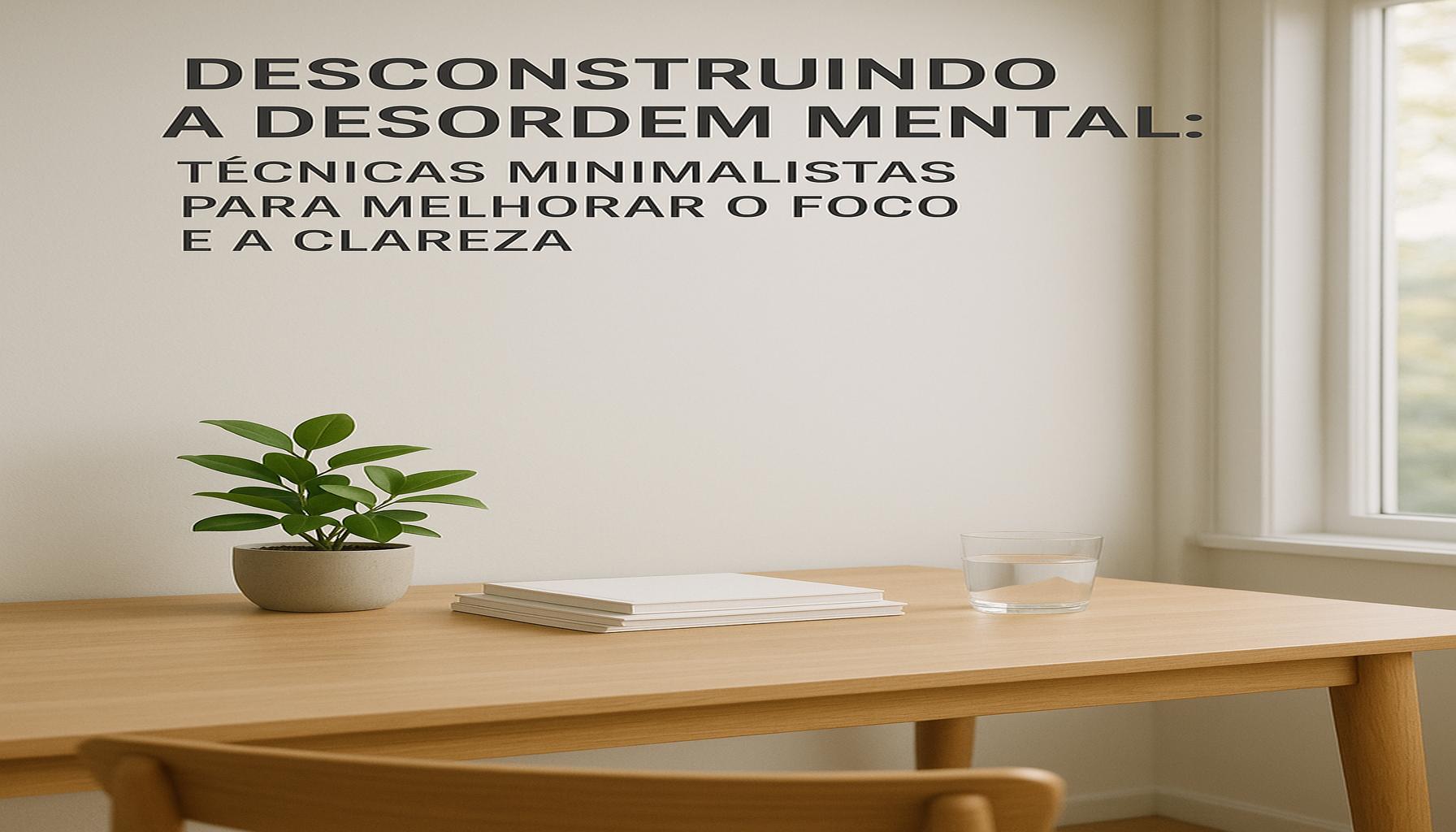The Connection between Minimalism and Goals: How to Simplify Objectives to Increase Clarity and Focus

Understanding Minimalism and Its Impact on Goal Achievement
In today’s fast-paced world, individuals are constantly bombarded with distractions. As a result, finding clarity and focus has become more important than ever. Minimalism offers a compelling solution by encouraging us to streamline our lives and concentrate on what truly matters. This lifestyle philosophy, once limited to aesthetic choices in home decor, has transcended into a powerful tool for goal management and personal development.
By simplifying objectives, we can enhance our productivity and overall well-being. Here’s how minimalism can fundamentally reshape our approach to goals:
- Reduces Overwhelm: With fewer distractions, from social media alerts to cluttered workspaces, we develop heightened focus. Studies have shown that a clutter-free environment can lead to improved mental clarity, enabling us to tackle tasks more effectively.
- Enhances Decision-Making: A clear understanding of priorities simplifies choices and helps us avoid decision fatigue. For instance, when you streamline your goal list to just a few critical ambitions, it becomes easier to allocate time and resources efficiently, promoting better outcomes.
- Fosters Deeper Engagement: By focusing on fewer goals, we allow ourselves to commit more thoroughly. This results in deeper engagement with our objectives, leading to higher quality work and a greater sense of satisfaction.
Imagine a life where your **objectives** are not lost in clutter. Minimalism invites us to reassess our ambitions, shedding the unnecessary for the essential. For instance, instead of juggling numerous projects at once—like balancing a full-time job, side hustles, and family obligations— you might concentrate on one significant goal at a time, such as securing a promotion or starting your own business.
This intentional approach elicits improved clarity and strengthens your overall commitment. As you strip away the nonessentials, whether they are distractions or unrealistic expectations, you pave the way for a more focused and rewarding pursuit of your dreams. Many successful individuals, including entrepreneurs like Tim Ferriss, advocate for this streamlined approach in their lives and work.
Join us as we delve deeper into the fascinating connection between minimalism and goal-setting. Through practical strategies such as the S.M.A.R.T. goal framework and the Pomodoro technique—which encourages short bursts of focused work to maximize productivity—discover how adopting minimalism can lead to a more centered and fulfilling life.

As you explore the potential of minimalism in your life, consider how small changes can cultivate a larger impact on goal achievement. Embracing this philosophy may not only redefine how you approach your ambitions but also enrich your overall quality of life.
DISCOVER MORE: Click here for practical decluttering tips
Embracing Minimalism: The Path to Clearer Goals
As we strive for success in our personal and professional lives, it is essential to establish a clear and actionable path toward our objectives. This is where minimalism plays a pivotal role. By distilling our ambitions into their most essential elements, we position ourselves to pursue our goals with renewed vigor and intent. The principles of minimalism not only promote a decluttered lifestyle but also provide a roadmap to enhance our goal-setting strategies.
A significant factor in achieving clarity of purpose lies in the understanding that not all goals are created equal. Minimalism encourages us to prioritize our aspirations, allowing for a laser-like focus on what truly matters. When we evaluate our objectives through a minimalist lens, we often come to realize that mere quantity does not equate to quality. The following insights illustrate how embracing minimalism can facilitate more effective goal management:
- Clarity in Purpose: Minimalism invites us to engage in deep reflection about our aspirations. It inspires us to ask probing questions: What do we genuinely want? Which pursuits resonate with our core values? This introspection enables us to craft goals that are not only attainable but also aligned with our true selves.
- Streamlined Focus: By narrowing our objectives to a select few, we reduce the chaos that often accompanies the pursuit of many goals at once. This streamlined focus allows us to develop targeted strategies and action plans, leading to more coherent progress over time.
- Systematic Review: A minimalist approach promotes regular evaluation of our progress. By assessing our goals and procedures, we can identify what is working and what needs adjustment. This iterative process empowers us to pivot as necessary, avoiding stagnation and fostering ongoing growth.
Take, for instance, the practical application of the S.M.A.R.T. goal framework. This system encourages us to set goals that are Specific, Measurable, Achievable, Relevant, and Time-bound. By applying such clarity to our objectives, we can eliminate ambiguity and reinforce our commitment to the tasks at hand. By integrating minimalistic principles with this framework, individuals can further distill their goals down to the core actions that will drive success.
For many people, the allure of multitasking can bog down productivity. Rather than juggling multiple projects, a minimalist mindset promotes allocating time to individual tasks, allowing for deeper concentration. This can be particularly effective for those looking to make strides in creative fields or startup environments, where focus can often make or break success. Research indicates that the human brain is not designed for multitasking, and with a singular focus, individuals are more likely to achieve innovative breakthroughs and meaningful advances in their work.
Ultimately, by marrying minimalism with our goal-setting endeavors, we empower ourselves to nurture not only our objectives but also our well-being. Shifting our mindset to embrace simplicity opens up collaborative dialogues within our communities, encouraging others to re-evaluate their own paths. As we progress through this exploration of minimalism and goal clarity, prepare to uncover techniques that can transform your aspirations into tangible achievements.
The Connection between Minimalism and Goals: How to Simplify Objectives to Increase Clarity and Focus
As experts in both minimalism and goal-setting continuously highlight, there’s a profound connection between adopting a minimalist lifestyle and achieving personal and professional success. By stripping away distractions and focusing on what truly matters, individuals can elevate their clarity and hone their focus on core objectives. In a world filled with noise and complexity, the strategic application of minimalism to goal-setting can lead to more manageable, achievable targets.
| Benefits of Minimalism | Impact on Goal Setting |
|---|---|
| Enhanced Focus | Minimalism reduces clutter, allowing for an unimpeded focus on your primary goals, boosting productivity and motivation. |
| Clearer Objectives | By narrowing down the essentials, individuals can define clear and specific goals, facilitating better planning and execution. |
Moreover, embracing minimalism often encourages individuals to develop a deeper understanding of their priorities. By assessing what truly contributes to their vision, they can discard unnecessary objectives that dilute their effort. For instance, someone might find that a multitude of side projects interferes with their main career goals; by minimizing these distractions, they can focus their energy where it counts.
Additionally, the values of minimalism often translate into time management strategies. When individuals prioritize tasks and eliminate the non-essential, they find they can allocate their time more wisely. This structured approach not only helps in maintaining a clear vision but also fosters a sense of achievement by allowing for progress in key areas, free from the overwhelm of multitasking or scattered objectives.
Ultimately, the journey towards optimizing goal achievement through minimalism invites exploration. Individuals can start small, perhaps by decluttering their workspace, creating a focused to-do list, or even setting aside time each week to reflect on their most important aspirations. By adopting these minimalist strategies, they may discover a newfound energy and ability to align their actions closely with their purpose.
DISCOVER MORE: Click here to learn how to create meaningful spaces
Strategic Simplification: Creating Actionable Steps Toward Your Goals
As we delve deeper into the intersection of minimalism and goal-setting, it becomes evident that simplifying objectives isn’t simply about decluttering tasks—it’s about aligning our intentions with meaningful actions. Minimalism encourages a discerning approach that prioritizes quality over quantity, equipping us to carve out actionable steps that propel us toward our goals. This methodology promotes efficiency and provides a clearer pathway through the uncertainty that often clouds our aspirations.
One powerful technique for practicing practical minimalism in goal-setting is the concept of chunking. This method involves breaking larger, complex goals into smaller, manageable tasks. For instance, rather than setting a vague objective like “get fit,” minimalism encourages you to specify the goal into chunks such as “walk for 30 minutes three times a week” or “prepare healthy meals for the week on Sundays.” By creating a roadmap with actionable chunks, you not only make progress feel achievable but also offer yourself immediate feedback when goals are accomplished.
Moreover, the two-minute rule, popularized by productivity expert David Allen in his bestselling book “Getting Things Done,” aligns seamlessly with minimalist principles. The rule suggests that if a task takes less than two minutes to complete, do it immediately. This encourages a proactive approach to tackling minor hurdles instead of allowing them to accumulate, thereby cultivating a sense of accomplishment and control. As you sustainably chip away at your to-do list, you’re more likely to develop momentum toward larger goals, maintaining a focused and minimalist approach.
Another area where minimalism significantly impacts goal clarity is in eliminating distractions. A minimalist lifestyle is often characterized by less noise, both physically and digitally. In our hyper-connected world, it’s easy to become overwhelmed by constant notifications and information overload, which can create mental clutter. Tools such as digital decluttering—sorting through files, emails, and even apps to only keep what adds value—can enhance focus. For example, routinely assessing your digital environment and keeping only those applications that support your goals can lead to higher productivity. When distractions are minimized, achieving a state of flow becomes more feasible, allowing for deeper engagement with tasks that matter most.
Additionally, exploring the realm of mindfulness can complement minimalism in goal-setting. Mindfulness practices, such as meditation or journaling, foster a heightened awareness of thoughts and emotions, helping to clarify desires and eliminate self-doubt. When individuals intentionally carve out even a few minutes a day for reflective practices, they often achieve heightened clarity around their goals. As a result, this enriched introspection directly ties back into minimalistic goals—focusing on cultivating what truly resonates rather than what is merely urgent.
Consider also the value of setting intentional deadlines for your goals. Minimalism advocates for establishing sensible timelines that are purposeful rather than arbitrary. By doing so, you are not only holding yourself accountable but also creating a sense of urgency that can enhance focus and propel you toward action. These deadlines, framed with a minimalist lens, should serve as motivators rather than sources of stress, prompting thoughtful engagement with your objectives.
As we explore these modern strategies, it becomes clear that integrating minimalism allows individuals to cultivate an environment that nourishes their ambitions. With each insightful step, we bolster our capability to achieve goals with clarity, focus, and a sense of purpose that resonates deeply within us.
DISCOVER MORE: Click here to unlock insights
Conclusion: Embracing Minimalism for Clearer Goal Achievement
In a world saturated with distractions and overwhelming choices, embracing minimalism offers a refreshing perspective on achieving our objectives. By understanding the connection between minimalism and clarity in goal-setting, we empower ourselves to streamline our aspirations and focus on what truly matters. The strategies we’ve explored—such as chunking tasks, applying the two-minute rule, and engaging in mindfulness—serve as vital tools in transforming our goals into attainable realities.
As we peel away the unnecessary layers of complexity, we cultivate an environment rich in focus and intention. The process of digital decluttering and prioritizing our commitments resonates deeply with the minimalist philosophy, allowing us to channel our energy toward significant pursuits rather than chasing fleeting distractions. Moreover, setting intentional deadlines not only motivates our progress but also reinforces a sense of accountability that can enhance our journey toward success.
Ultimately, minimalism is not simply a lifestyle choice; it is a powerful approach to goal achievement. By integrating these minimalist principles into our daily lives, we position ourselves to harness greater clarity, enhance our focus, and cultivate enduring fulfillment as we pursue our dreams. As we continue to navigate our complex lives, let us remember that simplifying our objectives can illuminate a clearer path toward reaching our fullest potential.


